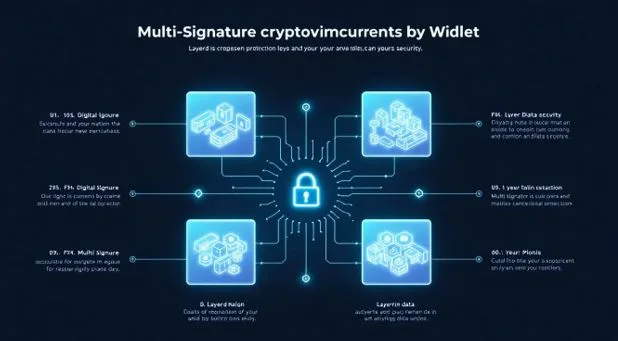Understanding Multi Signature Crypto Wallets: Enhanced Security for Your Assets
Multi-signature crypto wallets, or multisig wallets, enhance security by requiring more than one approval to authorize a transaction, making them a more secure alternative to traditional wallets. In an era where digital asset security is critical, understanding how these wallets function and their benefits is essential for protecting your investments. A crypto wallet development company can assist in designing and implementing multisig wallets that suit your specific security needs.
These wallets increase security by requiring multiple signatures for transaction authorization, reducing the risk of unauthorized access. They also offer customizable configurations, such as N-of-N and N-of-M settings, which can be tailored for both individuals and organizations. While multisig wallets provide significant security advantages, they can be more complex to manage and may result in transaction delays due to the need for multiple approvals.
What Are Multi Signature Crypto Wallets?
Multi signature wallets, often referred to as multisig wallets, are a type of cryptocurrency wallet that requires multiple signatures to authorize transactions. Unlike traditional wallets, which rely on a single private key for transaction validation, multi signature wallets enhance security by requiring multiple private keys. This ensures that no single party has unilateral control over the wallet, thereby significantly reducing the risk of unauthorized access or misuse.
The core principle behind multi signature wallets is the concept of shared authority:
- Requiring multiple signatures linked to different private keys ensures no single entity has complete control.
- Transactions can only be approved when the requisite number of signatures is obtained, adding a robust layer of security and accountability.
- For instance, requiring two out of three signatures to approve a transaction makes it much harder for malicious actors to compromise.
A key benefit is the ability to recover funds even if one of the seed phrases is lost. Multiple keys provide the following advantages:
- The remaining keys can access the wallet, providing an additional safety net.
- They enhance wallet security.
- They are attractive for individuals and organizations aiming to improve security, along with other keys.
How Do Multi Signature Wallets Work?
At the heart of a multi signature wallet lies the requirement for multiple cryptographic keys to approve transactions. Unlike traditional wallets that use a single private key, multi signature wallets need more than one signature to authorize a transaction. This approach ensures transactions are more secure, as they can’t be completed without necessary approvals from multiple key holders.
The operational mechanics of a multi signature wallet are straightforward yet ingenious:
- Any participant can initiate a transaction with their private key, but it remains pending until the required signatures are obtained.
- Each participant, known as a copayer, signs the transaction independently with their private key.
- This process ensures all involved parties agree before any funds are moved, enhancing wallet security.
They can be configured in various ways to suit different needs. Common configurations include:
- N-of-N: requiring all signers to approve a transaction.
- N-of-M: where a subset must approve.
- 3-of-4 setup: three out of four participants must sign off on a transaction for it to be validated.
This flexibility allowing users to tailor the security settings to their specific requirements, providing them with full control.
These configurations make multi signature wallets ideal for different use cases. Whether for business collective decision-making or for multiple individuals’ security, the customizable nature of these wallets ensures necessary protection and functionality, including multisig capabilities.
Advantages of Using Multi Sig Wallets
A compelling advantage is the significant decrease in the likelihood of unauthorized access to funds. Requiring multiple approvals ensures no single person can unilaterally access your funds or move funds, enhancing wallet security. This added protection is particularly beneficial for organizations and groups requiring collective approval for transactions.
Another major benefit is the customizable security settings these hardware wallets offer. Users can align security features with their operational requirements, whether setting the number of required signatures or defining key holders. This flexibility makes them highly adaptable to various use cases and user needs, providing unmatched control. Additionally, understanding crypto wallet security is essential for maximizing the effectiveness of these features. A ledger wallet can enhance this security further. Standard wallets can also provide a reliable option for users seeking simpler solutions.
The rise in digital currencies necessitates enhanced security measures, and multi-signature wallets play a pivotal role. As the value of digital assets grows, so does the importance of protecting them. Multi-signature wallets provide peace of mind by safeguarding funds with multiple layers of security, making them indispensable for serious cryptocurrency users and their crypto wallet.
Potential Drawbacks of Multi Signature Wallets
Despite their numerous advantages, multi-signature wallets are not without their challenges. One primary drawback is the complexity involved in managing these wallets. Coordinating multiple signers to authorize transactions is technically demanding and requires effective communication and planning. This complexity can be a barrier for some users, particularly those less tech-savvy.
Another issue is the delay in transaction processing. Since these wallets require the authorization of all involved parties, transactions can take longer to complete. This delay can be inconvenient, especially when quick access to funds is required. Additionally, the need for multiple signatories can result in higher transaction fees, as each signature needs verification.
Comparing Single Signature and Multi Signature Wallets
Comparing single signature wallets to multi signature wallets reveals stark differences. Multi signature wallets enhance security by requiring multiple approvals, making unauthorized access much more difficult. In contrast, single signature wallets rely on a single private key, which, if compromised, can lead to the loss of all funds. This makes multi signature wallets a far more secure option for safeguarding digital assets.
However, this enhanced security comes with an added layer of complexity. They require multiple parties to sign transactions, adding a layer of complexity compared to single signature wallets. This can make them less user-friendly, particularly for those who prefer straightforward, single-step processes.
Adoption is expected to increase as more recognize the risks associated with single point failures. Requiring multiple signatures for transaction approvals provides higher protection, making them a popular choice for mitigating risks and enhancing security in decentralized autonomous organizations.
Security Best Practices for Multi Signature Wallets
Maximizing the security benefits requires following best practices. A highly effective strategy is to distribute private keys across various devices and locations, including one private key. This significantly increases security by making it more challenging for malicious actors to steal all the crypto keys. Storing private keys in different locations further enhances security, especially when considering private and public keys.
Safeguarding recovery phrases is also critical. The recovery phrase generated during setup is crucial for accessing funds and should be secured in an offline environment to prevent unauthorized access. Never store recovery phrases on internet-connected devices, as this can expose them to cyber threats.
Regularly backing up wallets and verifying recovery phrases can protect against panic during emergencies. Maintaining a realistic protocol for wallet usage reduces the likelihood of human error leading to lost own funds that are stored in stores and potential theft.
Using multiple devices wallet providers and device types protects against potential failures, software issues, or data breaches. Emphasizing comprehensive security measures for the entire signing process ensures robust protection.
Summary
Multi signature crypto wallets represent a significant advancement in digital asset security. By requiring multiple signatures for transaction validation, they offer enhanced protection against unauthorized access and misuse of power. Their customizable security settings and the ability to recover funds even if one seed phrase is lost make them an attractive option for both individuals and organizations.
As the value of digital assets continues to rise, the importance of robust security measures cannot be overstated. Multi signature wallets provide a reliable and effective solution for safeguarding your cryptocurrency. By following best practices for securing these wallets, users can ensure that their digital assets are well-protected, offering peace of mind in an increasingly digital world.






